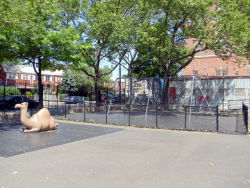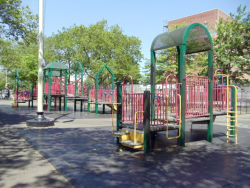Belmont Playground
Belmont Playground
Bounded by Pitkin Avenue, North Conduit Avenue, Drew Street, Forbell Street, and Belmont Avenue, Belmont Playground, as with the adjacent avenue, is named for August Belmont (1816-1890), a wealthy financier and diplomat. Belmont was born August Schonberg in the Rhineland-Palatinate portion of Germany. Born poor, and facing discrimination because he was Jewish, he left his small village at the age of thirteen for the city of Frankfurt, where he went to work for the largest Jewish banking house in Europe, The House of Rothschild. He began by sweeping floors, but quickly proved himself intelligent and trustworthy, and began to receive important assignments. In 1837, the Rothschilds sent him to be their representative in Cuba for important sugar negotiations.
Schonberg passed through New York City on the way over. The Panic of 1837 had just struck, wiping out many businesses and leaving Wall Street in a panic. Where Wall Street saw risk, Schonberg saw opportunity. He established his own bank and, using his Rothschild references, snapped up bankrupt firms, making himself a small fortune at the age of 21. To enhance his social stature in accordance with his new wealth, Schonberg changed his German surname to the French “Belmont,” meaning “beautiful mountain.” He joined the social clubs of the New York aristocracy, such as the Union Club and the Academy of Music, and threw lavish parties at his Fifth Avenue mansion. He also developed an interest in horse racing, which led him, in association with Leonard Jerome (1817-1891), to co-found the American Jockey Club and the Jerome Park Racetrack. He also founded the Belmont Stakes, a horse race that today constitutes the third and final race in horse racing’s Triple Crown.
Belmont’s son, also named August Belmont (1853-1924), was the businessman behind the construction of New York’s first subway, the Interborough Rapid Transit. The IRT line first opened on October 27, 1904, and became an instant success. In so doing, it initiated a transformation of the development pattern of New York City. It allowed overcrowded slums in the Lower East Side to empty out, and allowed distant portions of the outer boroughs (excepting Staten Island, which has no subway) to develop from rural areas into urban enclaves. Belmont was a meticulous manager, and his IRT achieved a reputation for reliable service, as well as immense profits. However, after his death, the IRT’s fortunes faded, damaged by inflation and competition with the automobile, until it was finally destroyed by the Depression and taken over by the city of New York as part of the municipal subway network. However, its tracks, tunnels, and trains continue to serve millions of New Yorkers, as it whisks passengers from place to place, the circulatory system for the city that never sleeps.
The title for Belmont Playground was vested in the City of New York in 1955 as an addition to the school site for PS 214, and the playground opened in 1957. Although the property belongs to the Board of Education, Parks and the Board of Education operate the playground jointly. Formerly known as PS 214 playground, it was renamed in 1985 by Commissioner Stern. It contains modular play equipment and handball and basketball courts. In 1997, the playground received a $76,073 requirements contract upgrade sponsored by Mayor Giuliani for refurbished sidewalks, paths, pavements and sitework. In 1998, Mayor Giuliani spent an additional $286,675 for new play equipment, safety surfacing, handball courts, and sitework.
Check out your park's Vital Signs
Clean & Safe
Green & Resilient
Empowered & Engaged Users
Share your feedback or learn more about how this park is part of a
Vital Park System


